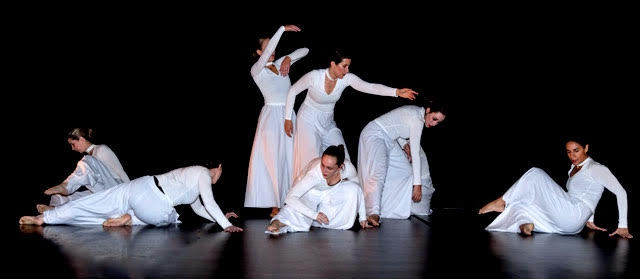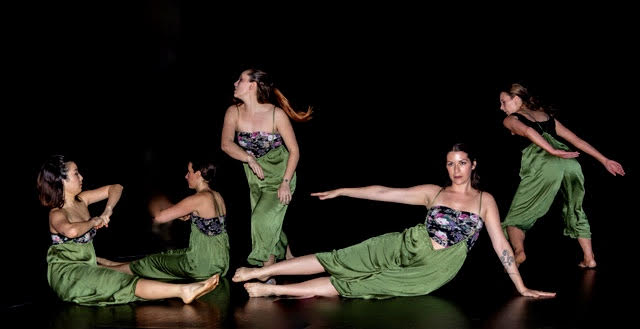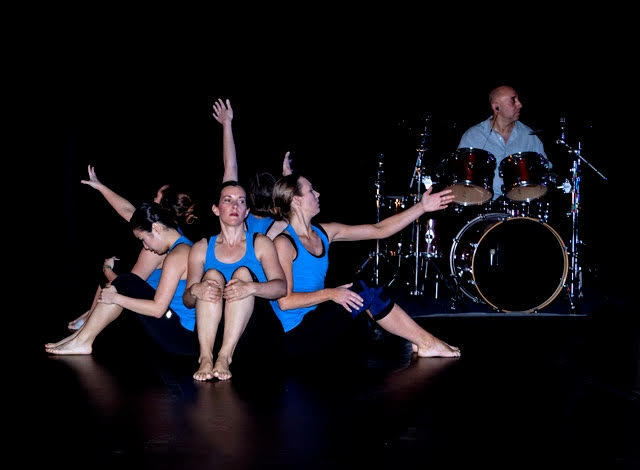Ascend Dance Collective – Ascension

Babel. Choreography by Donna K. Frogge. Photo by Ted Metcalf.
A few weeks ago I wrote about the work of Elisa De La Rosa, and considered her Tortillas y Lagrimas in the context of a few questions that I’ve been asking myself recently, particularly, what is the focus of a life in dance? I would also extend this conversation to, what makes a successful dance life. De La Rosa, as an educator exploring her choreographic concerns through her students, is operating outside the traditional presenting format seems to be on the brink of reaching these answers.
I returned to this personal investigation last weekend with Ascend Dance Collective’s Ascension. Ascend, under the direction of Donna K. Frogge and Nicola Bennett, is a new-ish company with the mission “to cultivate and promote a modern dance presence in the North Houston area.” The suburbs of Houston have long been the province of studio dance, so I was eager to see what this group of trained dancers was up to at their April 28 performance of Ascension.

Fluid Play. Choreography by Nicola Bennett. Photo by Ted Metcalf.
The company performed to a group of around seventy people at the Cypress Creek Christian Community Center near Spring; appropriately, then, much of the program had the sensibilities of a faith-based performance group. I would wager that the most interesting contribution to the program was Nicola Bennett’s “Fluid Play,” a dance ordered and designed the night of the show. The music and movement sequences were chosen by chance. Even so, the dancing was clear and focused, and the movement vocabulary was rich and well-prepared. I’m not sure how much was improvised, but the resulting composition was quite beautiful and I enjoyed watching the dancers put the pieces of the puzzle together in real time.
The dancers of Ascend seem to be at their best when their selected choreography is imbued with a sense of character and a bit of emotional depth, such as in “Woman’s Work,” created by company member Christine Chin. Maxwell’s earthy vocals offered a smooth, warm landscape to dance in a grounded, full-bodied manner which was refreshing to watch after the more traditional, sculpted pieces. Chin, by the way, is a stunning performer and I hope to see her in more Houston dance work.
For a small company building an appreciation for Modern dance in a community with very little of it, I very much appreciated the efforts to investigate big ideas and dig deep into the possibilities of the creative process. The most ambitious ensemble piece was the title work, “Ascension,” about the devastation wrought on the area by Hurricane Harvey.
Set to live accompaniment and narratives of those impacted by the flooding, there were revelatory moments of pain, frustration, and ultimately hope that were successfully realized through the dance. Despite uneven moments of transition and times when the movement quality did not quite match the drumming, it was a heartfelt look at a community in recovery. A solo sequence brought to life the story of Connie Brandt, who was away on vacation when Hurricane Harvey hit, and returned to a home in ruins. The solo evolved into a group sequence depicting the kind helping hands given to Brandt by her neighbors and fellow congregation members.

Ascension. Choreography by Donna K. Frogge, Nicola Bennett and Mirannda Lindberg-Clark. Photo by Ted Metcalf.
“Ascension” ended with a lovely movement sequence set to a prayer by Bruce D. Frogge. The type of Christina spirit portrayed in the dance, one of kindness, grace, and charity, is one difficult not to be in unison with, even for a nonbeliever.
Ascend Dance Collective seems to have a clear strength in its ensemble works, which explore space, timing, and phrase work. The choreography here is developed and pleasing to watch. The program’s smaller pieces did not have the same weight, and the ideas of those fragments did not seem sustainable. The company’s style of dancing is very much traditional, with a focus that appears to be set on codified, classical Modern dance steps. This was fully realized in Amy Spencer’s geometric “God is Great,” which was filled with handsome shapes and well-established canons. Like Islamic art, which eschews figurative representation for abstract lines and patterning, the piece moves like a revolving kaleidoscope of clean formations. Donna K. Frogge’s “Babel” was also a strong example of movement architecture and structured design, although I longed for a richer use of the body and perhaps more vibrant costumes.
It’s exciting to watch proponents of Modern dance carve out a space for themselves in the most unlikely of places. The two people next to me seemed to really enjoy what they were watching, so to know that their work is being accepted and appreciated is equally satisfying. Like the choreography on stage, much of which began as simple phrase work before evolving into more intricate complexities, I look on with a sense of curious wonder of what this collective will grow into next.



Recent Comments